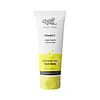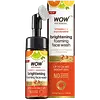What's inside
What's inside
 Key Ingredients
Key Ingredients

 Benefits
Benefits

 Concerns
Concerns

 Ingredients Side-by-side
Ingredients Side-by-side

Water
Skin ConditioningSodium C14-16 Olefin Sulfonate
CleansingCocamidopropyl Betaine
CleansingPropanediol
SolventSodium Cocoamphoacetate
CleansingSodium Cocoyl Isethionate
CleansingAcrylates/C10-30 Alkyl Acrylate Crosspolymer
Emulsion StabilisingGlycolic Acid
BufferingMyrciaria Dubia Fruit Extract
Skin ConditioningTerminalia Ferdinandiana Fruit Extract
AntioxidantSodium Lauroyl Sarcosinate
CleansingCeramide Ag
HumectantAlpha-Arbutin
Antioxidant3-O-Ethyl Ascorbic Acid
Skin ConditioningOryza Sativa Cera
Skin ConditioningNiacinamide
SmoothingParfum
MaskingPhenoxyethanol
PreservativePEG-7 Glyceryl Cocoate
EmulsifyingXanthan Gum
EmulsifyingCocamide Mea
EmulsifyingPhospholipids
Skin ConditioningSphingolipids
EmollientSodium Hydroxide
BufferingDisodium EDTA
Menthol
MaskingCI 19140
Cosmetic ColorantWater, Sodium C14-16 Olefin Sulfonate, Cocamidopropyl Betaine, Propanediol, Sodium Cocoamphoacetate, Sodium Cocoyl Isethionate, Acrylates/C10-30 Alkyl Acrylate Crosspolymer, Glycolic Acid, Myrciaria Dubia Fruit Extract, Terminalia Ferdinandiana Fruit Extract, Sodium Lauroyl Sarcosinate, Ceramide Ag, Alpha-Arbutin, 3-O-Ethyl Ascorbic Acid, Oryza Sativa Cera, Niacinamide, Parfum, Phenoxyethanol, PEG-7 Glyceryl Cocoate, Xanthan Gum, Cocamide Mea, Phospholipids, Sphingolipids, Sodium Hydroxide, Disodium EDTA, Menthol, CI 19140
Water
Skin ConditioningPropylene Glycol
HumectantSodium PCA
Humectant3-O-Ethyl Ascorbic Acid
Skin ConditioningPhenoxyethanol
PreservativeEthylhexylglycerin
Skin ConditioningSodium Benzoate
MaskingAloe Barbadensis Leaf Extract
EmollientNiacinamide
SmoothingAscorbyl Methylsilanol Pectinate
AntioxidantPPG-12-Buteth-16
Skin ConditioningDimethylsilanol Hyaluronate
HumectantHydroxyethylcellulose
Emulsion StabilisingCitric Acid
BufferingParfum
MaskingSodium Gluconate
Skin ConditioningXanthan Gum
EmulsifyingDipotassium Glycyrrhizate
HumectantCitrus Limon Peel Oil
MaskingMentha Citrata Herb Oil
PerfumingWater, Propylene Glycol, Sodium PCA, 3-O-Ethyl Ascorbic Acid, Phenoxyethanol, Ethylhexylglycerin, Sodium Benzoate, Aloe Barbadensis Leaf Extract, Niacinamide, Ascorbyl Methylsilanol Pectinate, PPG-12-Buteth-16, Dimethylsilanol Hyaluronate, Hydroxyethylcellulose, Citric Acid, Parfum, Sodium Gluconate, Xanthan Gum, Dipotassium Glycyrrhizate, Citrus Limon Peel Oil, Mentha Citrata Herb Oil
Ingredients Explained
These ingredients are found in both products.
Ingredients higher up in an ingredient list are typically present in a larger amount.
You might know this ingredient as Ethyl Ascorbic Acid, a more stable version of ascorbic acid.
Like other types of vitamin C, this ingredient has many benefits including reducing wrinkles, skin soothing, dark spot fading, and fighting against free radicals.
3-O-Ethyl Ascorbic Acid interferes with the process of skin darkening, helping to reduce hyperpigmentation. It also encourages the skin to produce more collagen.
Once applied, 3-O-Ethyl Ascorbic Acid is converted to Vitamin C deeper in the skin's layers. This process is slow but makes this ingredient more tolerable for skin.
The optimum pH range for this ingredient is 4 - 5.5
Learn more about 3-O-Ethyl Ascorbic AcidNiacinamide is a multitasking form of vitamin B3 that strengthens the skin barrier, reduces pores and dark spots, regulates oil, and improves signs of aging.
And the best part? It's gentle and well-tolerated by most skin types, including sensitive and reactive skin.
You might have heard of "niacin flush", or the reddening of skin that causes itchiness. Niacinamide has not been found to cause this.
In very rare cases, some individuals may not be able to tolerate niacinamide at all or experience an allergic reaction to it.
If you are experiencing flaking, irritation, and dryness with this ingredient, be sure to double check all your products as this ingredient can be found in all categories of skincare.
When incorporating niacinamide into your routine, look out for concentration amounts. Typically, 5% niacinamide provides benefits such as fading dark spots. However, if you have sensitive skin, it is better to begin with a smaller concentration.
When you apply niacinamide to your skin, your body converts it into nicotinamide adenine dinucleotide (NAD). NAD is an essential coenzyme that is already found in your cells as "fuel" and powers countless biological processes.
In your skin, NAD helps repair cell damage, produce new healthy cells, support collagen production, strengthen the skin barrier, and fight environmental stressors (like UV and pollution).
Our natural NAD levels start to decline with age, leading to slower skin repair, visible aging, and a weaker skin barrier. By providing your skin niacinamide, you're recharging your skin's NAD levels. This leads to stronger, healthier, and younger looking skin.
Another name for vitamin B3 is nicotinamide. This vitamin is water-soluble and our bodies don't store it. We obtain Vitamin B3 from either food or skincare. Meat, fish, wheat, yeast, and leafy greens contain vitamin B3.
The type of niacinamide used in skincare is synthetically created.
Learn more about NiacinamideParfum is a catch-all term for an ingredient or more that is used to give a scent to products.
Also called "fragrance", this ingredient can be a blend of hundreds of chemicals or plant oils. This means every product with "fragrance" or "parfum" in the ingredients list is a different mixture.
For instance, Habanolide is a proprietary trade name for a specific aroma chemical. When used as a fragrance ingredient in cosmetics, most aroma chemicals fall under the broad labeling category of “FRAGRANCE” or “PARFUM” according to EU and US regulations.
The term 'parfum' or 'fragrance' is not regulated in many countries. In many cases, it is up to the brand to define this term.
For instance, many brands choose to label themselves as "fragrance-free" because they are not using synthetic fragrances. However, their products may still contain ingredients such as essential oils that are considered a fragrance by INCI standards.
One example is Calendula flower extract. Calendula is an essential oil that still imparts a scent or 'fragrance'.
Depending on the blend, the ingredients in the mixture can cause allergies and sensitivities on the skin. Some ingredients that are known EU allergens include linalool and citronellol.
Parfum can also be used to mask or cover an unpleasant scent.
The bottom line is: not all fragrances/parfum/ingredients are created equally. If you are worried about fragrances, we recommend taking a closer look at an ingredient. And of course, we always recommend speaking with a professional.
Learn more about ParfumPhenoxyethanol is a preservative that has germicide, antimicrobial, and aromatic properties. Studies show that phenoxyethanol can prevent microbial growth. By itself, it has a scent that is similar to that of a rose.
It's often used in formulations along with Caprylyl Glycol to preserve the shelf life of products.
Water. It's the most common cosmetic ingredient of all. You'll usually see it at the top of ingredient lists, meaning that it makes up the largest part of the product.
So why is it so popular? Water most often acts as a solvent - this means that it helps dissolve other ingredients into the formulation.
You'll also recognize water as that liquid we all need to stay alive. If you see this, drink a glass of water. Stay hydrated!
Learn more about WaterXanthan gum is used as a stabilizer and thickener within cosmetic products. It helps give products a sticky, thick feeling - preventing them from being too runny.
On the technical side of things, xanthan gum is a polysaccharide - a combination consisting of multiple sugar molecules bonded together.
Xanthan gum is a pretty common and great ingredient. It is a natural, non-toxic, non-irritating ingredient that is also commonly used in food products.
Learn more about Xanthan Gum